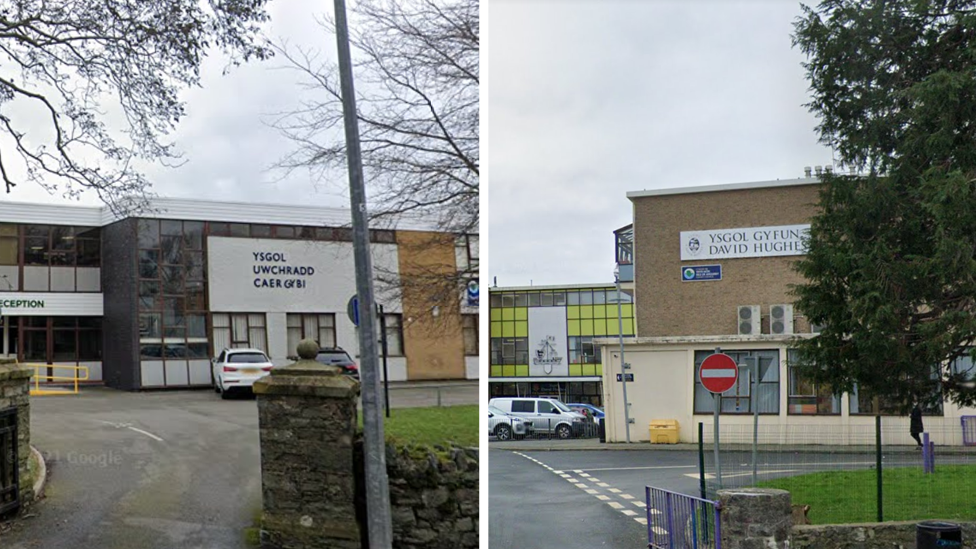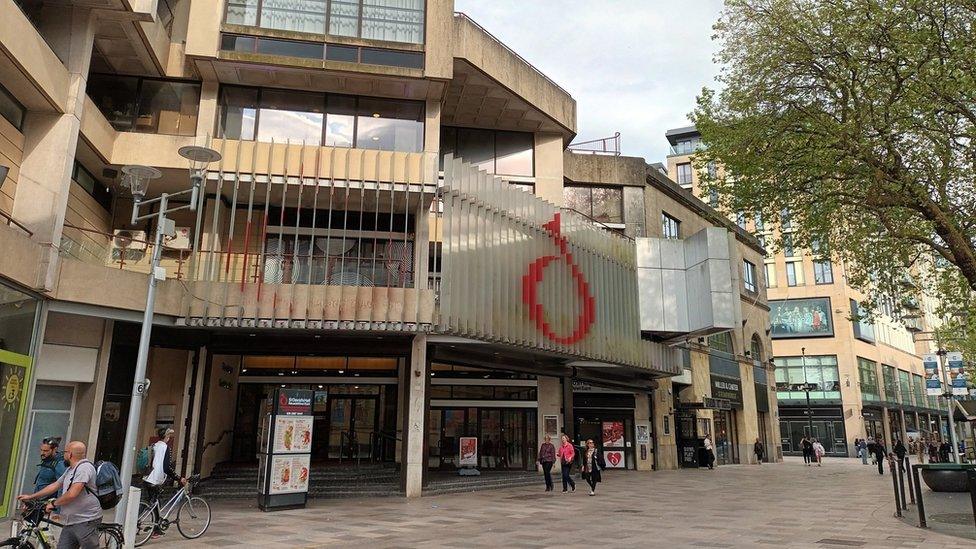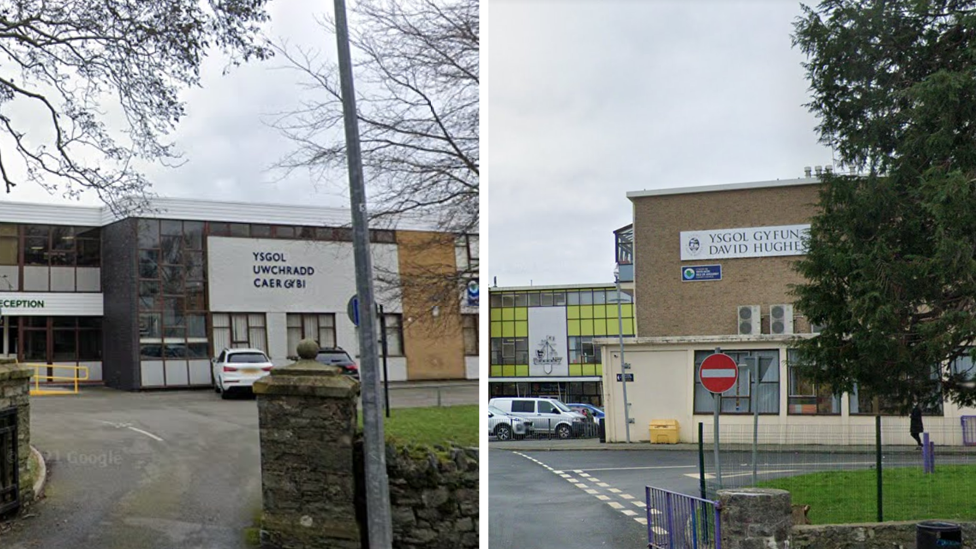Concrete: How safe are schools and public buildings in Wales?
- Published

Some pupils are not able to return to the classroom at the start of the new school year
As children return to school from their summer break, fears over the safety of the concrete used to construct some school buildings mean some pupils will not be back in the classroom.
Two schools on Anglesey have been identified as containing potentially dangerous reinforced autoclaved aerated concrete (Raac).
Further work is being undertaken to ensure schools are safe.
But how prevalent is the issue of Raac in Wales?
What is Raac?
Construction expert Keith Jones said Raac is a light "bubbly" concrete, which meant it was used in roofs, but that it doesn't have the "inherent strength of reinforced concrete and has a limited shelf life".
"I think the important thing to remember is that it is different, it is identifiable, it's got this bubbly texture," Mr Jones said.
The Health and Safety Executive said Raac was "now life-expired", and was "liable to collapse with little or no notice".
Is there Raac in Welsh schools?
Two schools on Anglesey - Ysgol David Hughes and Ysgol Uwchradd Caergybi - closed because of concerns over concrete.
Anglesey Council said Ysgol David Hughes would welcome back all year groups to the school building on Tuesday 12 September.
Some areas of the building would, however, continue to be unavailable.
Conwy council closed one primary school on 14 September until the end of the week after Raac was found in the building.
Conwy council said early indications were that the material found at Ysgol Maes Owen in Kinmel Bay was in good condition, but it was taking a "cautious approach".
Denbighshire council closed Ysgol Trefnant in Denbigh on Thursday 14 September for the rest of the week after Raac was found.
Swansea council has said RAAC had not been found in its schools, while Denbighshire says it has surveyed all its buildings and not found the material.
Bridgend said surveyors were being sent to any school where the use of Raac could not be ruled out while Cardiff council said "to date" no Raac had been found in its schools.
Carmarthenshire said it does not anticipate discovering signs of Raac but said following preliminary assessments said it is holding further surveys.

Ysgol Uwchradd Caergybi and Ysgol David Hughes in Anglesey have been closed
Ceredigion said it had no immediate concerns but was conducting further assessments.
Flintshire said Raac has not been reported in its own rolling programme of condition surveys on council-owned buildings.
Gwynedd said there is no Raac in any of their schools and they are checking other public buildings.
Pembrokeshire said none of the concrete had been identified in its properties "to date".
Meanwhile, Merthyr Tydfil said it had not found Raac slabs after inspecting 23 out of 29 buildings.
Monmouthshire added that it had conducted "initial reviews" and is working with the Welsh government as assessments take place at 12 schools.
Cardiff council announced concert venue St David's Hall would close for at least four weeks for assessment work.
The council completed inspections at 115 schools across the city and said it was happy that none of its schools contain reinforced autoclaved aerated concrete.
Where else has Raac been found in Wales?
Bridgend Indoor Market was closed with immediate effect after Raac was identified in its roof.
One Cardiff University building has been closed as a "precautionary measure until appropriate remedial works have been completed."
Three wards in Withybush Hospital, in Haverfordwest, Pembrokeshire recently moved patients after the concrete was found. A spokesperson said patients were moved to other parts of Pembrokeshire.
The material was also found in a "limited part" of Bronglais Hospital in Aberystwyth, Ceredigion.
At Nevill Hall Hospital in Abergavenny, four offices, part of the restaurant and the chapel were closed earlier this month after Raac was identified.
Raac has been identified within the catering department at Bryn Y Neuadd Hospital, Conwy county, with the facility relocated to another building while further surveys are carried out.
The Welsh government has said Raac does "not appear to be a widespread issue" in hospitals in Wales, and that all health boards have been asked to carry out survey work.
Bangor University, which is reviewing its estate, said in a statement that it has placed no entry signs on areas where it has not concluded inspections, but it said they were spaces "where access is normally restricted".
"At the present time we have not identified any immediate concerns with our main buildings," it said.
Colegau Cymru and the University of South Wales are the only Welsh education settings to confirm to BBC Wales News they are not impacted.
St David's Hall in Cardiff contains Raac, Cardiff council said, and has been subject to thorough and regular inspections by specialists for over 18 months.
"During that time the local authority has received reports that there has been no deterioration in the condition of Raac present at the venue, and it remains safe to operate as normal," the council said.
Plans were in place to undertake the remedial work required in the medium - to long-term, it said.
South Wales Fire and Rescue had said it has been unable to rule out the use Raac at four of its sites, and will conduct further testing.
Gwent, North Wales and Dyfed-Powys Police have all confirmed none of their buildings contain Raac, and South Wales Police has said none of its "main buildings" do, with a small number still being surveyed.
What is the Welsh government doing about the issue?
Education Minister Jeremy Miles said the government was working with councils and would identify "over this week and next week" any schools which may be at risk .
"There has been clear guidance on how to manage Raac safely in public buildings for a number of years," he said.
"Obviously when new information comes to light which has a possible bearing on safety you've got to take that seriously in a precautionary way and act quickly," he added.
Related topics
- Published5 September 2023

- Published5 September 2023

- Published4 September 2023

- Published1 September 2023
